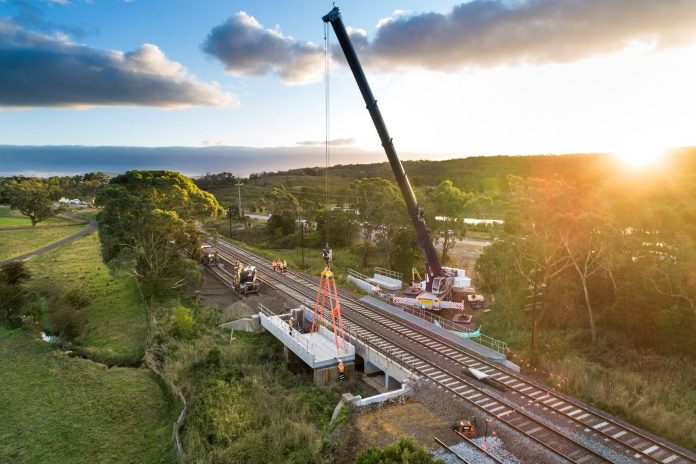Australia is both the flattest continent on earth and, with the exception of Antarctica, the driest. You can travel 2,000-odd miles across its plains, between Sydney and Perth, without seeing very much at all. At the same time, Australia’s population is spiralling; it is expected to double to 45 million by 2070, according to Deloitte. Most of its inhabitants, now and in the future, reside in its major cities.
Australia’s transport sector is already strained, with increased road congestion, higher parking costs, and deepening environmental concerns. Public transportation has emerged as the preferred way to move both people and freight. Rail, in particular, is poised to play a significant role in meeting sustainability goals: rail uses 90 percent less energy than trucks, per unit of freight.
It is the “only transport mode offering serious competition with trucks for land-based freight,” according to the International Energy Agency.
Australian Rail Track Corporation (ARTC) is one of those shouldering the burden, and looking to make business out of digitally-optimised rail services. It is one Australia’s largest rail network owners, responsible for over 20 percent of rail track (8,500 kilometres of standard gauge track) on the continent, across South Australia, Victoria, Western Australia, New South Wales, and Queensland. It wants to make rail the transport-mode of choice for logistics in Australia.
But the complexity of maintaining rail assets and ensuring compliance with state health and safety regulations has grown with demand for rail transport. ARTC has sought to digitize its network to help manage and reduce this complexity. The company has invested “billions of dollars”, it says, to extend and upgrade its network to get both passengers and freight onto the rails, and off the roads.
Of course, its ‘modernisation’ programme goes back in time, as well. Fifteen years ago, ARTC deployed an enterprise asset management system (Ellipse) from ABB’s power grids division, rolled into a joint venture with Japanese industrialist Hitachi in July this year, as Hitachi ABB Power Grids. It was, says the Swiss-Japanese venture, “the first step” in ARTC’s digital journey, enabling it to plan and track its maintenance activities.
“There are really three categories of assets we have in our purview,” explains Brian Green, general manager for asset management at ARTC. “These are infrastructure, people, and information.”
The firm became very good at collecting data, but has been less good at sorting it. “ARTC found it collected a high volume of information from field-based teams, but the quality of this data was low. Low quality data is costly both in terms of safety and productivity,” comments a spokesperson for Hitachi ABB Power Grids.
Green comments: “We needed to transform our current system and processes in order to optimize the quality of the data we collect as an asset that we rely on in order to stay within regulatory compliance. Without this, we cannot ensure safe and efficient business operations.”
Workforce management was the order of the day. ARTC has over 300 mobile workers servicing its entire network. Field work – including inspections and corrective work for the track, structures, and signaling assets – had been managed on paper, and transcribed into spreadsheets. Data accuracy was a concern, technicians struggled to follow asset management plans, and time-lags on data input impacted on safety, operational, and productivity.
ARTC engaged Hitachi ABB Power Grids, again, to take a smartphone-based digital enterprise workforce management (‘WFM’) solution, to provide frontline teams with predefined workflows to drive best practices and standardized input options. ARTC digitized not only its paper-based processes, but its entire enterprise strategy, expanding the reach of the Ellipse platform, as well, so maintenance managers could predefine process steps and data integrity rules, as another way to improve data quality and work priorities.
Brian Glawson, senior project manager for asset systems at ARTC, says: “ARTC’s mobile workers have turned in their clipboards, paper, and pens in exchange for tablets and phones, and they have embraced this change.”
Noel Milton, track inspector for ARTC, comments: “Our digital enterprise WFM solution proactively tells us what tasks have to be completed at a given time to remain in compliance. The system is very easy to use – we can see our tasks or work orders in a list or map view – and it allows us to update the status of our jobs extremely fast. This system saves me hours in productivity each week.”
Network Rail Consulting was recently engaged to audit ARTC maintenance standards and compliance. The audit found ARTC’s compliance record is “supported enormously” by the Ellipse system. “The use of the asset management is as good as we have seen amongst our clients both in Australia and globally and we are continuing to work with Hitachi ABB Power Grids to enhance this yet further.”
It added: “We recognize that ARTC’s use of this system, particularly with respect to managing defects, is world leading.”
Yep Min Teo, vice president of Asia Pacific at Hitachi ABB Power Grids, comments: “Hitachi ABB Power Grids enables some of the world’s largest railway operators to minimize risks across their network, enhance operational and financial performance, and execute the right strategies for the future. We recognize that ARTC is a global leader in asset management practices and we are proud to be part of their journey.”

